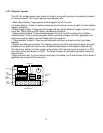
11
Quantization shifts your playing to the specified beat while you play, so choose the desired
value before tapping out your rhythms. Remember that you can also change quantization
while recording if, for example, you want to record snare with eighth note quantization but
high-hats with 16th note quantization.
Note: The quantize value also sets the step length in Step Edit mode (section 2.9).
Background As you record a Pattern, quantization shifts all drum events to the nearest selected rhythmic value
to eliminate small timing errors. Example: With a quantize value of 1/16, all drum events you play will be shifted to
the nearest 16th note.
Quantization is most effective when used sparingly. If you're recording a drum part, quantize the kick and snare,
but try recording the hi-hat in real time (or quantize the hi-hat, and record the snare in real time). Another trick is to
combine both quantized and non-quantized parts. Example: hand claps often sound too mechanical when
quantized—when humans clap hands, you end up with a bunch of different sounds happening within a few
milliseconds of each other. A good way to simulate this effect (yet still have a rock-solid rhythm) is to record a
quantized hand claps part, then turn off quantization and try to double the part. Sometimes what you overdub will
be right on the beat, but sometimes it will be off by just enough to add that human touch.
2.2 PAGE 2: SELECT THE SWING VALUE (SWING SELECT)
The display shows SWING SELECT; the Swing window shows the swing value.
SWING
PAGE
SELECT
SETUP
RECORD
SWING
OFF
Enter the desired swing percentage with the INC/DEC or number buttons (1 = 54%, 2 = 58%,
3 = 62%, 4-0 = Swing Off).
Swing shifts notes as specified while you record, so choose the desired value before tapping
out your rhythms.
Background Swing affects the timing of pairs of equal-value notes. Each note normally defaults to taking up
50% of the total duration of both notes; adding swing lengthens the first note of the pair, and to keep the total
duration of both notes the same, shortens the second note of the pair. This imparts the kind of feel found in
shuffles and some jazz tunes. Example: With Swing set to 62%, the first note of the pair takes up 62% of the total
duration of the pair of notes, while the second note takes up 38% of the total duration.


















